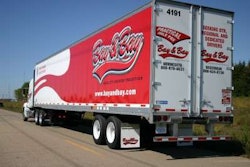The first thing I noticed was the large number of old trucks running around – all makes and models, including a battalion of tough old cabovers that once felt right at home in a world of disco balls and Bandit Trans Ams.
And that struck me as odd. Because I was traveling into the Port of Long Beach – ground zero in California’s war to condemn all pre-1989 tractors to the boneyards, and to force OEMs and fleet owners alike to manufacture and deploy cleaner alternative-fuel trucks throughout the state.
Given the current state of affairs in California, it was impossible to look upon those old trucks without acknowledging that their days are numbered. As we all know, the Golden State will be enacting some of the toughest clean air laws in the world over the next decade. And no matter how much character or panache your aging rigs have, they simply aren’t going to make the cut.
I was in Long Beach for Daimler Trucks North America’s press conference – along with many of the movers and shakers of California’s clean air movement – to witness Sterling’s delivery of 132 liquid natural gas (LNG)-powered Class 8 tractors to the port, a major first step in “forever melding world commerce with environmental stewardship,” in the words of Mark Lampert, DTNA’s senior vice president of North American sales.
The sale is a sort of last hurrah for Sterling. Daimler announced late last year it would discontinue the brand in response to the softening economy. But Chris Patterson, DTNA president and chief executive officer, stresses that the Freightliner and Western Star brands remain committed to the company’s “three pillars” of “sustainable mobility,” including natural gas-powered trucks, hybrids and fuel cell/battery drive vehicles.
The 113-inch Set-Back Axle trucks were delivered to drivers contracting with California Cartage Co., whose president, Robert Curry Sr., told journalists that he “wanted to be part of the solution and not the problem,” and that his company was “100 percent committed to building a clean drayage truck fleet for use in both Long Beach and the Port of Los Angeles.”
As for the tractors themselves, they were very impressive. Instead of one fuel tank mounted on each side of the truck, there were two narrower tanks – but other than that, nothing seemed out of place. The first thing you noticed when starting one up was how quiet it ran at idle. There’s no diesel knock, of course, but these are even stealthier than gasoline engines. On top of that, there were no fumes or smoke at all. And a quick trip into the port – including a brief interstate run – showed the Sterling LNG to be as capable as any truck on the road.
And that, I suppose, is the main lesson I drew from my California visit: There are just too many factors dictating change in the trucking industry today, from fuel prices to freight shortages to environmental regulations. Change is no longer optional, and the companies that adapt to new technology and regulations are the ones that will be successful. But change also can deliver promising new technology, as Sterling shows with its 113-inch LNG tractor.










